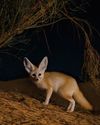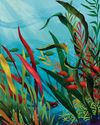Intentar ORO - Gratis
Flight fantastic
BBC Wildlife
|July 2023
Summer is the time to see insects on the wing. But how do these diverse and myriad creatures take flight?

THERE IS, ACCORDING TO author Douglas Adams, a knack to flying: throw yourself at the ground and miss. Humans are terrible at flying. We are too big, too heavy, too wingless. Insects, though, thrive in the air, and developing the ability to fly has played a large part in their success. With wings you can escape a predator; move to more advantageous habitats; radiate, diversify and take over the world. The first insect flew at least 325 million years ago, and it quickly caught on. Like the Duke of York's men, once they were up they were up- and for them there was no coming down.
Insect flight manifests itself in many different ways, whether it's the breathtaking control of a dragonfly, the exasperating agility of a house fly, the winsome scattering of a cabbage white, the dogged whirring of a stag beetle or the clumsy bumblings of a daddy long legs.
The principle is simple: four forces - lift, thrust, weight and drag - act on a flying body. Produce enough lift and thrust to counteract the weight and drag, and up you go. Yet the reality is more complex. The conundrum facing any flyer is to combine lightness with strength. Insects solve this by making their wings from the same stuff predominant in their exoskeletons: chitin.
The typical insect wing is a sandwich of this highly effective, lightweight material: two layers squeezed together and interlaced with a network of veins, which serve the dual purpose of strengthening the wing and circulating blood (haemolymph in insects).
SO THAT'S THE LIGHTNESS AND strength taken care of. But to get (and stay) in the air you need a form of propulsion and, as an insect wing contains no muscle, that must come from the body. Insects have evolved two solutions for this. The simpler version is the direct flight mechanism, which is utilised by two orders: Ephemeroptera (mayflies) and Odonata (dragonflies and damselflies), as well as some cockroaches.
Esta historia es de la edición July 2023 de BBC Wildlife.
Suscríbete a Magzter GOLD para acceder a miles de historias premium seleccionadas y a más de 9000 revistas y periódicos.
¿Ya eres suscriptor? Iniciar sesión
MÁS HISTORIAS DE BBC Wildlife

BBC Wildlife
"I was terrified the elephant would ram us"
African elephant in Kenya
2 mins
January 2026

BBC Wildlife
ALL YOU EVER NEEDED TO KNOW ABOUT THE Fennec fox
THE FENNEC FOX IS THE SMALLEST fox in the world, with a body length that can be as little as 24cm.
3 mins
January 2026

BBC Wildlife
INTO THE PLASTISPHERE
A unique synthetic ecosystem is evolving in our oceans – welcome to the plastisphere
7 mins
January 2026

BBC Wildlife
“More than half of all animal life exists in a parasitic relationship, and all life lives in symbiosis”
Our survival depends on species evolving to live together - but some relationships take dark turns
7 mins
January 2026

BBC Wildlife
Are animals able to dream?
SLEEP IS A MYSTERIOUS THING. FOR A long time, we weren't sure why we do it.
1 mins
January 2026

BBC Wildlife
Does a cuckoo know it's a cuckoo?
ABSURD LITTLE BIRDS ACROSS THE world lay their eggs in the nests of other species, leaving the hapless parents to raise a changeling at the expense of their own offspring.
2 mins
January 2026

BBC Wildlife
Orcas killing young sharks
Juvenile great whites are easy prey for orca pod
1 mins
January 2026

BBC Wildlife
Ocean goes on tour
Acclaimed film touring the UK, backed by live orchestra and choir
1 min
January 2026

BBC Wildlife
Feisty bats hunt like lions
Winged mammals use a 'hang and wait' strategy to take down large prey
1 mins
January 2026

BBC Wildlife
SNAP-CHAT
Richard Birchett on magical merlins, wily coyotes and charging deer
2 mins
January 2026
Translate
Change font size
